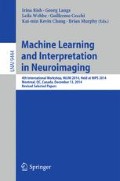Abstract
Sparse Canonical Correlation Analysis (SCCA) has been proposed to find pairs of sparse weight vectors that maximize correlations between sets of paired variables. This is done by computing one weight vector pair, deflating the correlation matrix between the views, and then repeating the process to compute the next pair. However, the deflation step used does not guarantee the orthogonality of the vector pairs. This is a very important requirement if one wishes to study the space spanned by these vectors, which should have very promising neuroscience applications. In the present work, we propose a new method for performing the deflation step in SCCA models. The ability of these vector pairs to generalize to new data was tested using an open-access dementia dataset which included T1-weighted MRI images and clinical information. The proposed method provided weight vector pairs that were both orthogonal and able to generalize to new data.
Access this chapter
Tax calculation will be finalised at checkout
Purchases are for personal use only
References
Ashburner, J.: A fast diffeomorphic image registration algorithm. Neuroimage 38(1), 95–113 (2007)
Boutte, D., Liu, J.: Sparse canonical correlation analysis applied to fMRI and genetic data fusion. In: 2010 IEEE International Conference on Bioinformatics and Biomedicine (BIBM), pp. 422–426. IEEE (2010)
Chi, E.C., Allen, G.I., Zhou, H., Kohannim, O., Lange, K., Thompson, P.M.: Imaging genetics via sparse canonical correlation analysis. In: 2013 IEEE 10th International Symposium on Biomedical Imaging (ISBI), pp. 740–743. IEEE (2013)
Ecker, C., Marquand, A., Mourão-Miranda, J., Johnston, P., Daly, E.M., Brammer, M.J., Maltezos, S., Murphy, C.M., Robertson, D., Williams, S.C., et al.: Describing the brain in autism in five dimensions–magnetic resonance imaging-assisted diagnosis of autism spectrum disorder using a multiparameter classification approach. J. Neurosci. 30(32), 10612–10623 (2010)
Gretton, A., Bousquet, O., Smola, A.J., Schölkopf, B.: Measuring statistical dependence with Hilbert-Schmidt norms. In: Jain, S., Simon, H.U., Tomita, E. (eds.) ALT 2005. LNCS (LNAI), vol. 3734, pp. 63–77. Springer, Heidelberg (2005)
Klöppel, S., Stonnington, C.M., Chu, C., Draganski, B., Scahill, R.I., Rohrer, J.D., Fox, N.C., Jack, C.R., Ashburner, J., Frackowiak, R.S.: Automatic classification of MR scans in Alzheimer’s disease. Brain 131(3), 681–689 (2008)
Marcus, D.S., Fotenos, A.F., Csernansky, J.G., Morris, J.C., Buckner, R.L.: Open access series of imaging studies: longitudinal MRI data in nondemented and demented older adults. J. Cogn. Neurosci. 22(12), 2677–2684 (2009)
Mourão-Miranda, J., Bokde, A.L., Born, C., Hampel, H., Stetter, M.: Classifying brain states and determining the discriminating activation patterns: support vector machine on functional MRI data. NeuroImage 28(4), 980–995 (2005)
Nouretdinov, I., Costafreda, S.G., Gammerman, A., Chervonenkis, A., Vovk, V., Vapnik, V., Fu, C.H.: Machine learning classification with confidence: application of transductive conformal predictors to MRI-based diagnostic and prognostic markers in depression. Neuroimage 56(2), 809–813 (2011)
Orrù, G., Pettersson-Yeo, W., Marquand, A.F., Sartori, G., Mechelli, A.: Using support vector machine to identify imaging biomarkers of neurological and psychiatric disease: a critical review. Neurosci. Biobehav. Rev. 36(4), 1140–1152 (2012)
Parkhomenko, E., Tritchler, D., Beyene, J.: Sparse canonical correlation analysis with application to genomic data integration. Stat. Appl. Genet. Mol. Biol. 8(1), 1–34 (2009)
Rao, A., Lee, Y., Gass, A., Monsch, A.: Classification of Alzheimer’s disease from structural MRI using sparse logistic regression with optional spatial regularization. In: 2011 Annual International Conference of the IEEE Engineering in Medicine and Biology Society, EMBC, pp. 4499–4502. IEEE (2011)
Shawe-Taylor, J., Cristianini, N.: Kernel Methods for Pattern Analysis. Cambridge University Press, Cambridge (2004)
Wan, J., et al.: Hippocampal surface mapping of genetic risk factors in AD via sparse learning models. In: Fichtinger, G., Martel, A., Peters, T. (eds.) MICCAI 2011, Part II. LNCS, vol. 6892, pp. 376–383. Springer, Heidelberg (2011)
Wellcome Trust Centre for Neuroimaging: SPM software - Statistical Parametric Mapping. http://www.fil.ion.ucl.ac.uk/spm/software/
Witten, D.M., Tibshirani, R., Hastie, T.: A penalized matrix decomposition, with applications to sparse principal components and canonical correlation analysis. Biostatistics, kxp008 (2009)
Witten, D.M., Tibshirani, R.J.: Extensions of sparse canonical correlation analysis with applications to genomic data. Stat. Appl. Genet. Mol. Biol. 8(1), 1–27 (2009)
Acknowledgments
João M. Monteiro was supported by a PhD scholarship awarded by Fundação para a Ciência e a Tecnologia (SFRH/BD/88345/2012).
Janaina Mourão-Miranda was supported by the Wellcome Trust under grants No. WT086565/Z/08/Z and No. WT102845/Z/13/Z.
The authors would like to acknowledge the OASIS dataset, which was funded by the following grants: P50 AG05681, P01 AG03991, R01 AG021910, P50 MH071616, U24 RR021382, R01 MH56584.
Author information
Authors and Affiliations
Corresponding author
Editor information
Editors and Affiliations
Rights and permissions
Copyright information
© 2016 Springer International Publishing AG
About this paper
Cite this paper
Monteiro, J.M., Rao, A., Ashburner, J., Shawe-Taylor, J., Mourão-Miranda, J. (2016). Leveraging Clinical Data to Enhance Localization of Brain Atrophy. In: Rish, I., Langs, G., Wehbe, L., Cecchi, G., Chang, Km., Murphy, B. (eds) Machine Learning and Interpretation in Neuroimaging. MLINI MLINI 2013 2014. Lecture Notes in Computer Science(), vol 9444. Springer, Cham. https://doi.org/10.1007/978-3-319-45174-9_7
Download citation
DOI: https://doi.org/10.1007/978-3-319-45174-9_7
Published:
Publisher Name: Springer, Cham
Print ISBN: 978-3-319-45173-2
Online ISBN: 978-3-319-45174-9
eBook Packages: Computer ScienceComputer Science (R0)

